|
|

|
Porsche, and the Porsche crest are registered trademarks of Dr. Ing. h.c. F. Porsche AG.
This site is not affiliated with Porsche in any way. Its only purpose is to provide an online forum for car enthusiasts. All other trademarks are property of their respective owners. |
|
|
  |
| anderssj |
 Jan 12 2020, 12:10 PM Jan 12 2020, 12:10 PM
Post
#1
|
|
Dog is my copilot...    Group: Members Posts: 1,748 Joined: 28-January 03 From: VA Member No.: 207 Region Association: MidAtlantic Region 
|
I finally got around to installing the turbo tie rods I purchased from Pelican almost 4 years ago (!). I thought I should share some pictures from the install in hopes they might help somebody do the same job in the future (standard disclaimers apply--"your mileage may vary," etc.)
A couple of things up front: First, this upgrade is well worth doing. It made my car's steering much more precise, bringing it back to better-than-new levels. Second, earlier threads here in the garage were extremely helpful, especially GWN7's from back 2006: http://www.914world.com/bbs2/index.php?sho...c=56323&hl= Thanks to all who have shared their thoughts and pictures in this and other related threads! Third, those who have done this job without a lift, using only jack stands, etc., are amazing. Here's to you! (IMG:style_emoticons/default/beerchug.gif) I was lucky to have a lift, otherwise I'd still be under the car. The kit I bought from Pelican included two Lemforder tie-rod assemblies and a pair of boots. I also bought a pair of tie rod washers ("spacers"). All parts seem very well made. I also bought one of the custom-made tie rod wrenches during a group buy here on the world (more on that later). As far as general procedures, I followed the steps in GWN7's thread (as I said, very helpful). I did the right/passenger side first, so as to avoid working around the brake master cylinder until I was up on the learning curve a little. And now for the work itself: This may seem obvious, but first I disconnected the battery. Leaving the key in the on position let me "steer" the rack from left to right to improve access, and didn't want to risk hurting anything in the ignition. I also used a brush and compressed air to get rid of any crap that could fall into/onto the rack. Then, after removing the front wheel I used a tie rod separator (and a BFH) to remove the outer tie rod: 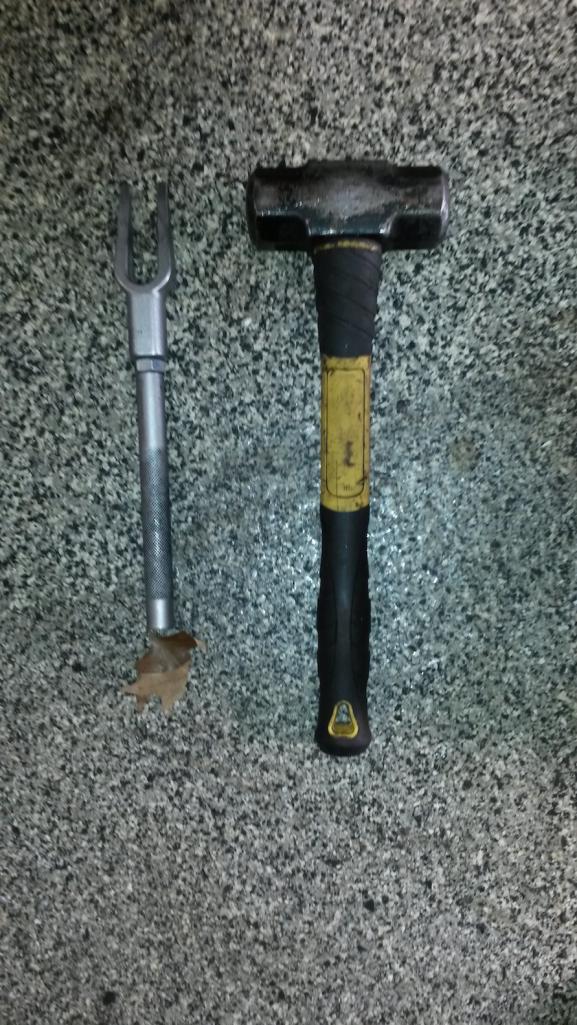 The tie rod separator is also referred to as a "pickle fork"... The only odd thing I found here was that the nut on the right side was a Nyloc-type, not the castle nut/cotter pin I expected. Not sure who did that or when--but it was in keeping with some of the other odd stuff I found when replacing the clutch last month. With the tie rod hanging down, I pushed the outer end of the old boot back (towards the center of the car) and off the retainer. Left the spring on the boot for safe keeping. I used the "group buy wrench" to loosen the boot retainer. 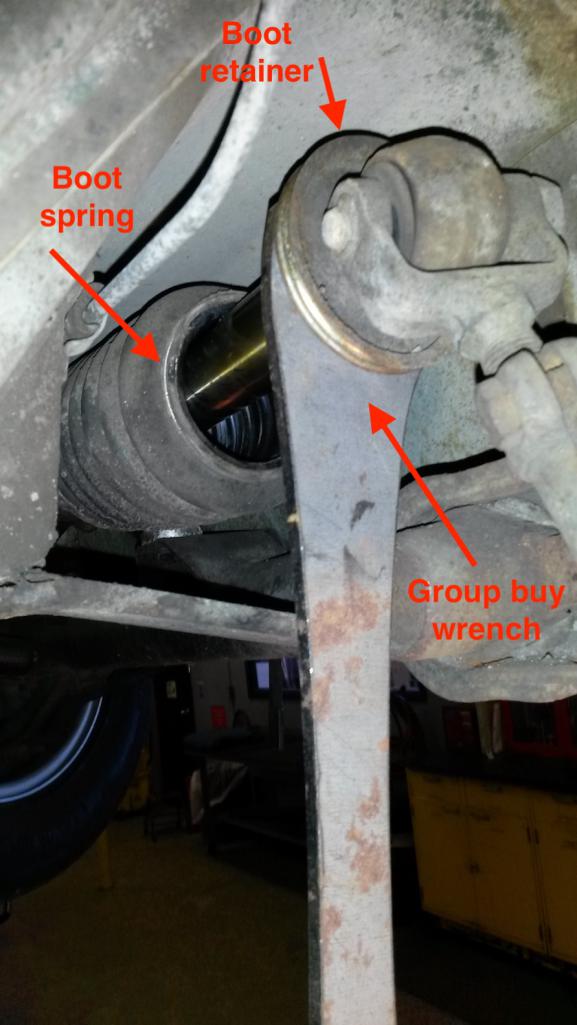 Another view... 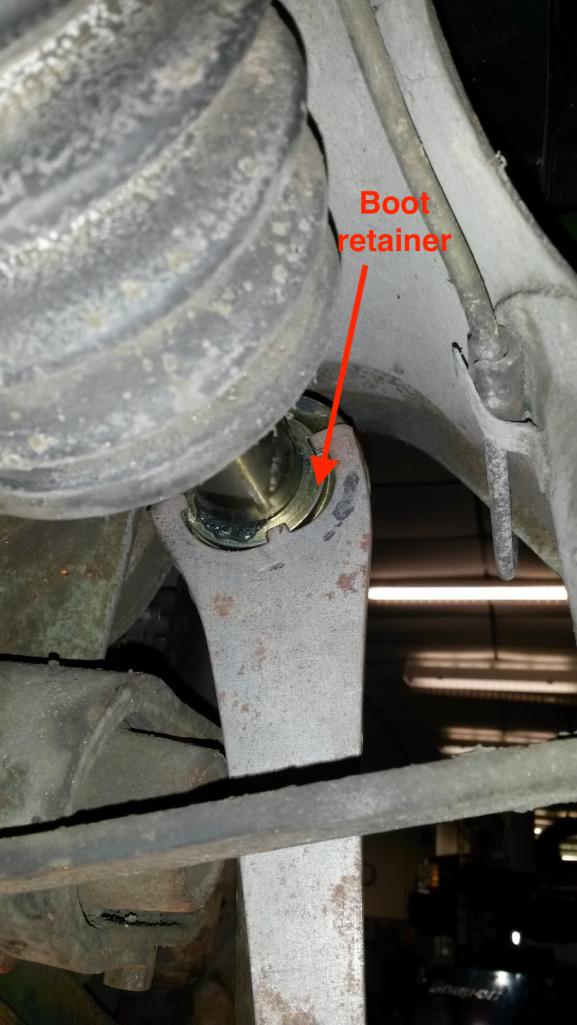 The wrench fit the boot retainer well and made loosening it easy. Observation: I think retaining the boot is only one function of this piece--given that the boot retainer is threaded and tightened to 51ft-lb (per Haynes, page 99), I think it also serves as a "jam nut" for the tie rod eye bolt. Too bad it wouldn't fit inside the new boot, or I'd have been tempted to reuse it instead of the new spacer. |
| anderssj |
 Jan 12 2020, 01:05 PM Jan 12 2020, 01:05 PM
Post
#2
|
|
Dog is my copilot...    Group: Members Posts: 1,748 Joined: 28-January 03 From: VA Member No.: 207 Region Association: MidAtlantic Region 
|
And this is where the trouble began...
The next step was to remove the eye bolt from the end of the rack. On-line videos showed people simply spinning it out of the rack--no such luck in this case. It was TIGHT. I used a couple of penetrants (PBlaster, etc.); I finally had to use a big set of locking pliers to remove the eyebolt. Lack of space (watch out for that brake pipe!) really limited the tool's swing. I spent over an hour on this. Lesson learned--have a small pipe wrench on hand for next time. 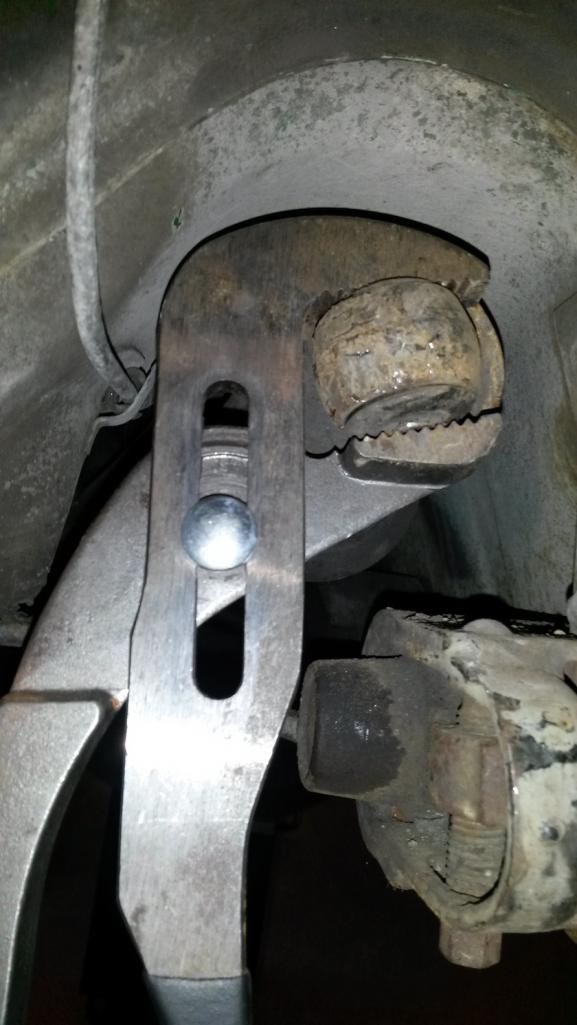 There had been some question on whether the new spacers were required to keep the turbo tie rods from bottoming out in the rack, so I decide to measure the depth of the hole using a tire tread gauge. 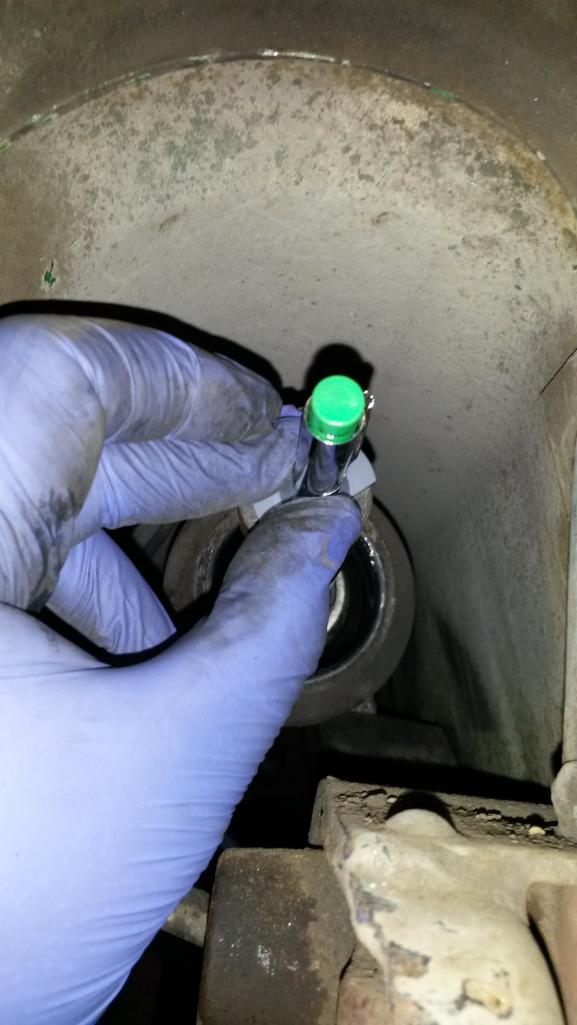 On my car, the hole in the end of the rack is over an inch deep (35/32"). That's a couple of mm deeper than the length of the stud on the end of the new tie rod (without the spacer): 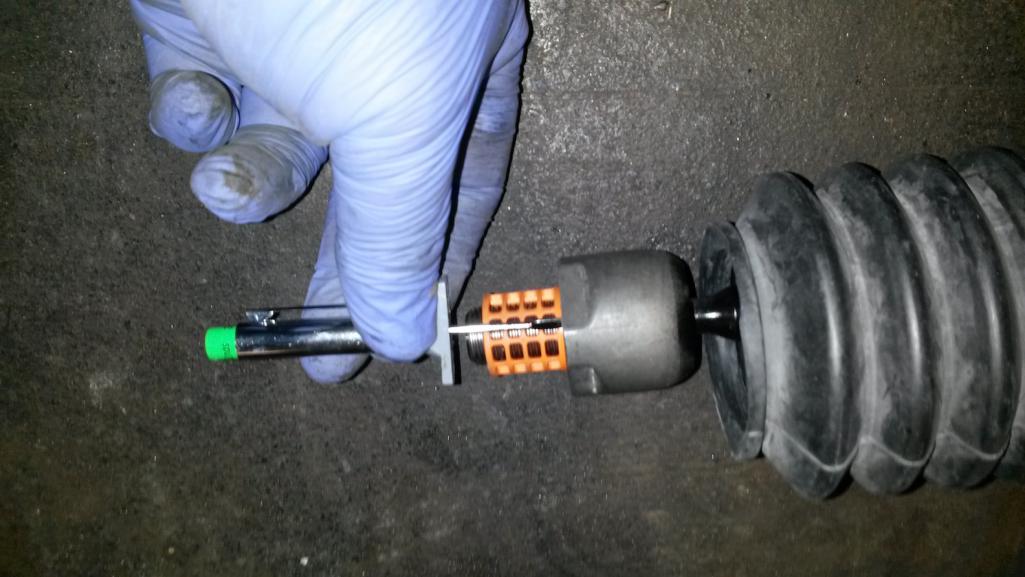 It doesn't look like bottoming out would be a problem, so the spacer must be there to keep the inner end of the turbo tie rod from hitting the end of the rack housing when the steering is at full lock. Next, slide the inner boot spring towards the center of the car and onto the rack housing, then remove the old boot taking care not to drop any crap onto the rack. 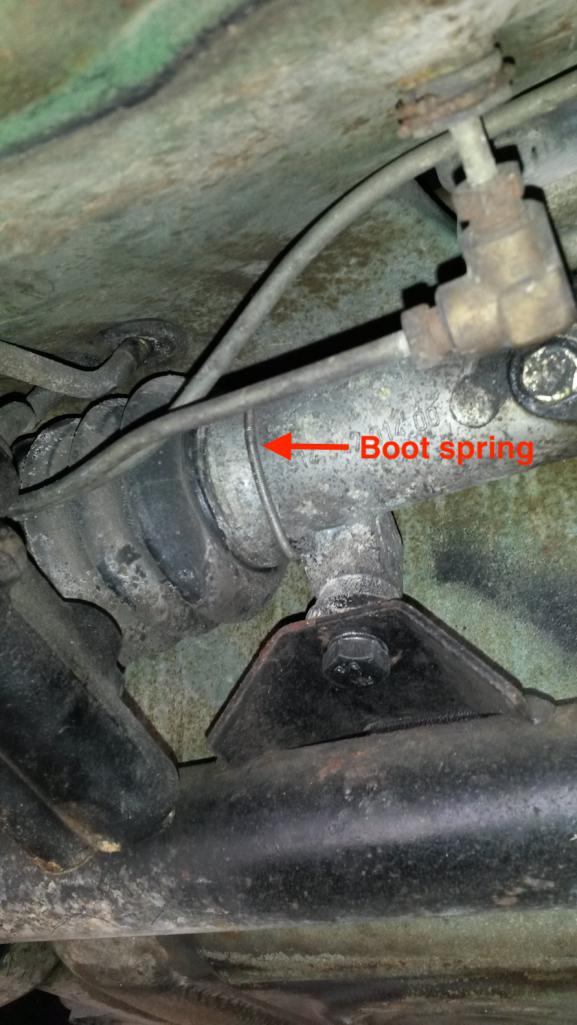 Sorry this pic is from the left side of the car--but you get the idea. I used a little brake cleaner on a Q-tip to clean out the hole in the end of the rack, put a little thread locker on the threaded end of the new tie rod and screwed it up snug. Then I used the Group Buy wrench to tighten it up: 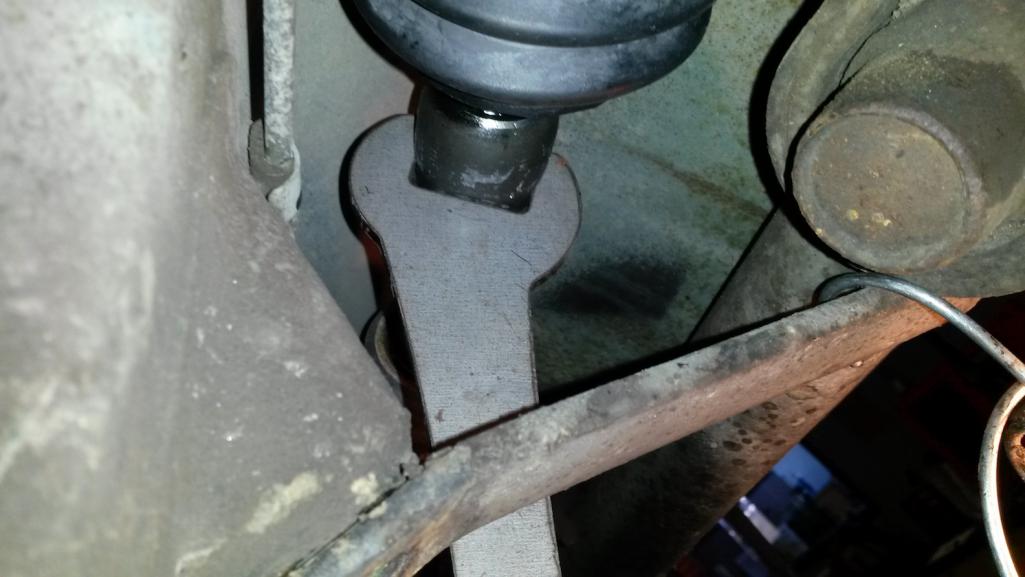 Haynes (page 99) lists the tightening torque for the eyebolt as 34 ft-lb, so that's what I was shooting for. About the time I thought I was close, I could feel the end of the wrench start to open up... (IMG:style_emoticons/default/dry.gif) 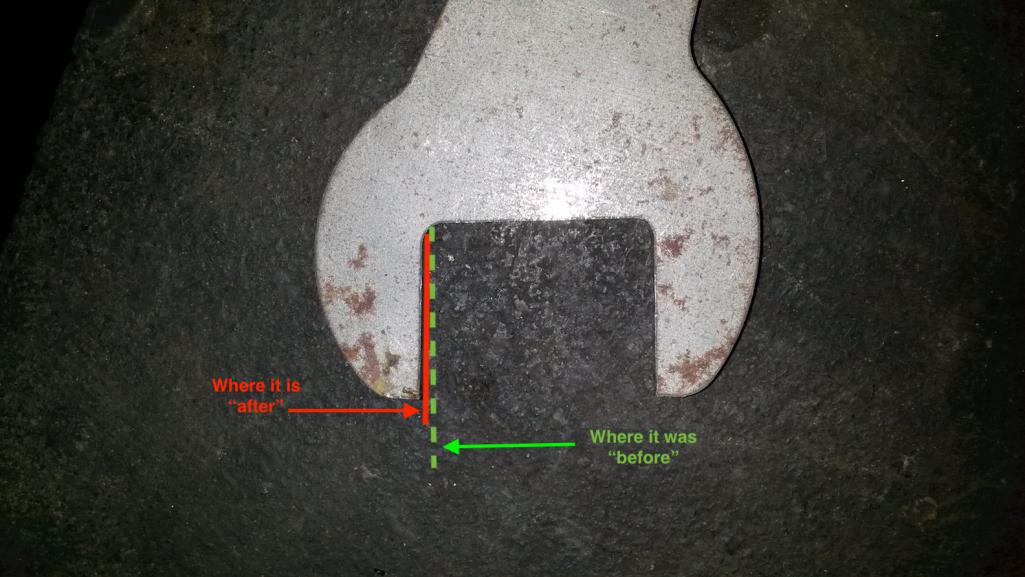 I was really being pretty careful, so I don't think it was a "Bullwinkle" ("Don't know my own strength") moment.  I used the channel lock pliers to make sure the new tie rod was tight. Lesson learned (again)--have a small pipe wrench on hand for next time. OK, wifey.gov just asked to go for a ride in the 914, so there will be a short interruption... |
| Montreal914 |
 Jan 12 2020, 01:48 PM Jan 12 2020, 01:48 PM
Post
#3
|
|
Senior Member    Group: Members Posts: 1,854 Joined: 8-August 10 From: Claremont, CA Member No.: 12,023 Region Association: Southern California 
|
Nice write up, looking forward to the rest. (IMG:style_emoticons/default/popcorn[1].gif)
|
| Tdskip |
 Jan 12 2020, 03:38 PM Jan 12 2020, 03:38 PM
Post
#4
|
|
Advanced Member     Group: Members Posts: 3,737 Joined: 1-December 17 From: soCal Member No.: 21,666 Region Association: None 
|
Nice job, thanks for posting
|
| anderssj |
 Jan 12 2020, 10:46 PM Jan 12 2020, 10:46 PM
Post
#5
|
|
Dog is my copilot...    Group: Members Posts: 1,748 Joined: 28-January 03 From: VA Member No.: 207 Region Association: MidAtlantic Region 
|
Doggone it--we got back from our drive and the power was out. Seems a tree limb dropped across a wire near here.
I meant to mention in the last post that I measured the length of the old tie rod (with the boot retainer threaded onto the eyebolt) from the rack side of the boot retainer to the center of the tie rod end (what Haynes calls the tie rod ball joint). Then I disassembled the new tie rod, slipped the boot on, and put on the new tie rod end. I adjusted its length so that when measured from the rack side of the spacer to the center of the tie rod ball joint, the new assembly matched the measurement of the old part. Sorry, should have taken a picture. FWIW, I put the boot on the assembly before I screwed it into the rack... As far as installing the boot, it went easier than I expected. I used glycerin as a lube, both around the outside of the rack housing and the inside of the boot. Highly recommended--glycerin is slicker than deer guts on a doorknob, and it won't harm the boot. I just kind of pushed and twisted/rotated the boot onto the rack housing (a little past where it is supposed to go) and it popped on. That said, I had to pull out on it with a pliers while easing it back down the rack housing a little to free part of the lip that had gotten tucked under. Once it was in place, I was able lift the retaining spring onto the lip with a small screw driver, then roll it on the rest of the way with my thumb (rotating the boot helps as you walk the retaining spring into place). 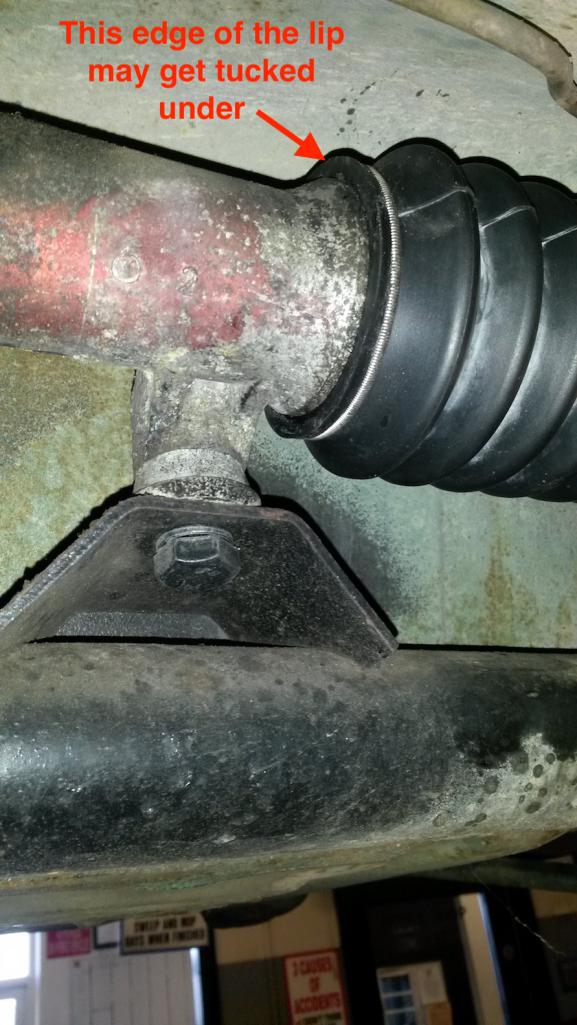 The outer end of the boot rides on a black rubber collar/disc on the tie rod. Once again, glycerin is your friend--used on the disc and on the inner lip of the boot. I pushed the boot lip onto the top of the disc with my thumb, then worked the rest of the onto the disc by pulling out on the boot with pliers while pushing the lip onto the disc. Sorry, it sounds more confusing than it really is... 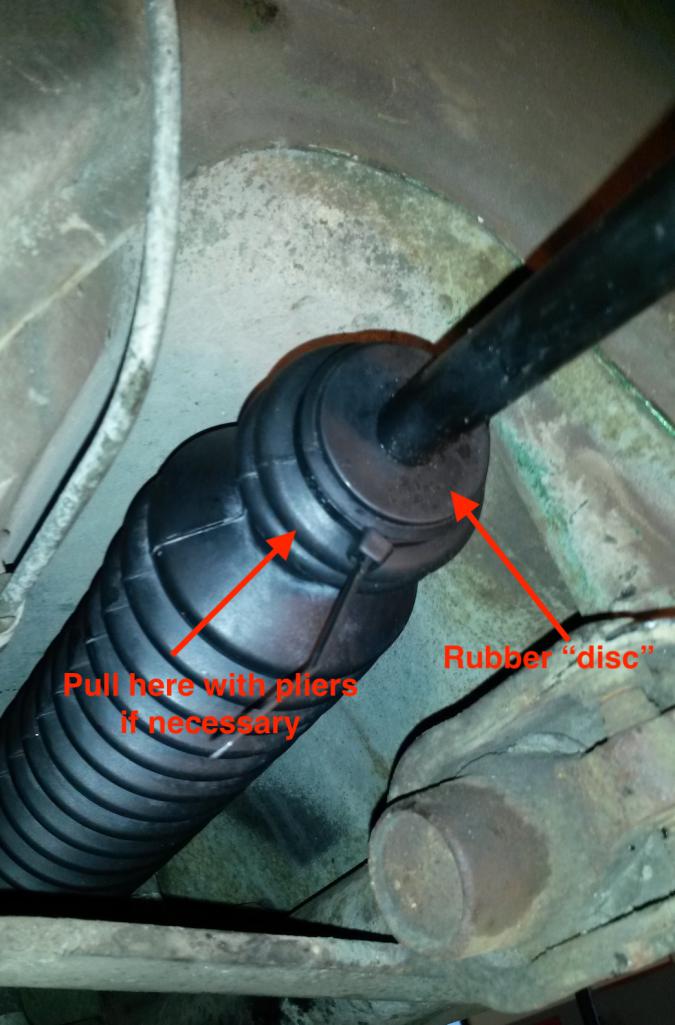 That said, it does take some pressure to get the boot in place. On the driver's side, I actually displaced the rubber disc a little; if that happens, just pull it back out the tie rod into the indentation where it belongs (indent is bare metal in this picture). 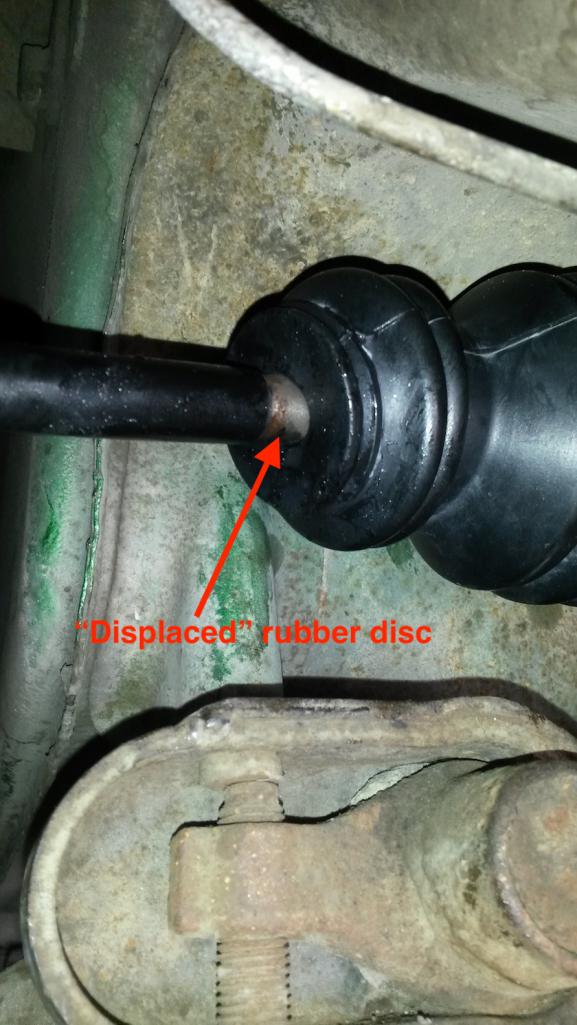 FWIW, this particular set of tie rods was shipped with two different sets of lock nuts instead of castle nuts--and the tie rod ball joints weren't drilled for cotter pins. I used the cone-shaped nut on the left, as it's the same type as used on our old Volvos--and if it's safe enough for Volvo, then it's safe enough for the 914 (IMG:style_emoticons/default/biggrin.gif) 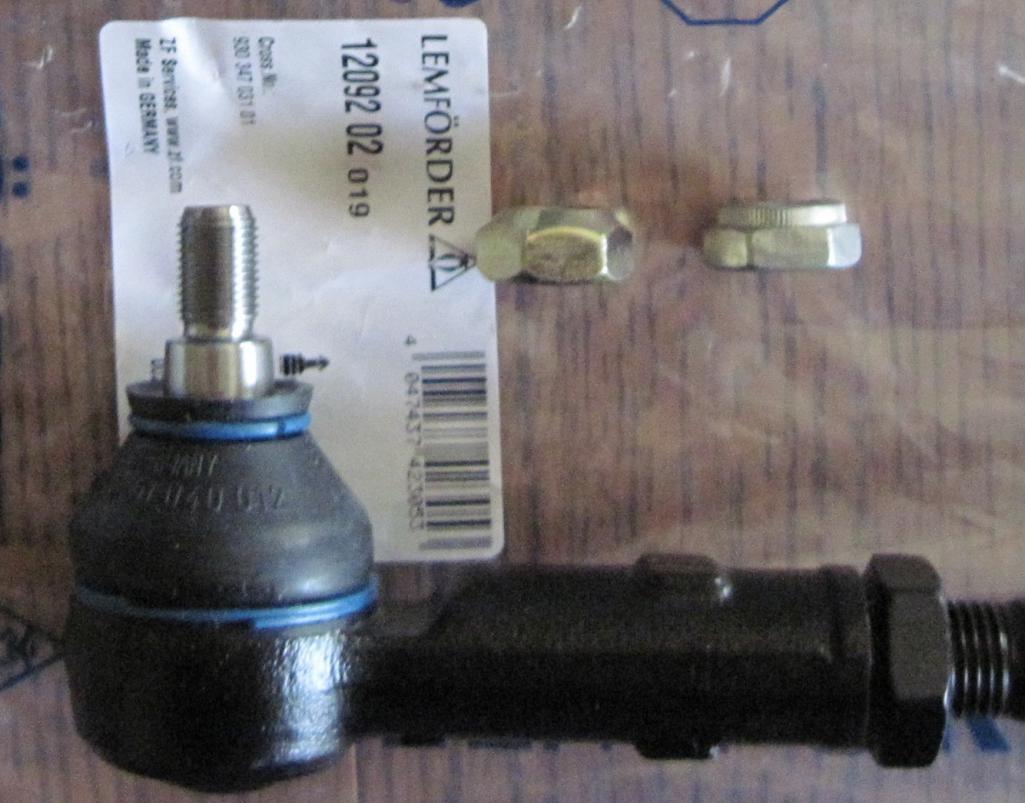 Because this type of lock nut its "pinched," it will only go freely on a couple of threads. Trying to screw it further onto the threaded shank of the tie rod end will just cause that shank to turn. However, by applying some upwards pressure from underneath the tie rod end, you can keep the threaded shank from turning while you install the nut. A hydraulic jack and a block of wood works nicely... 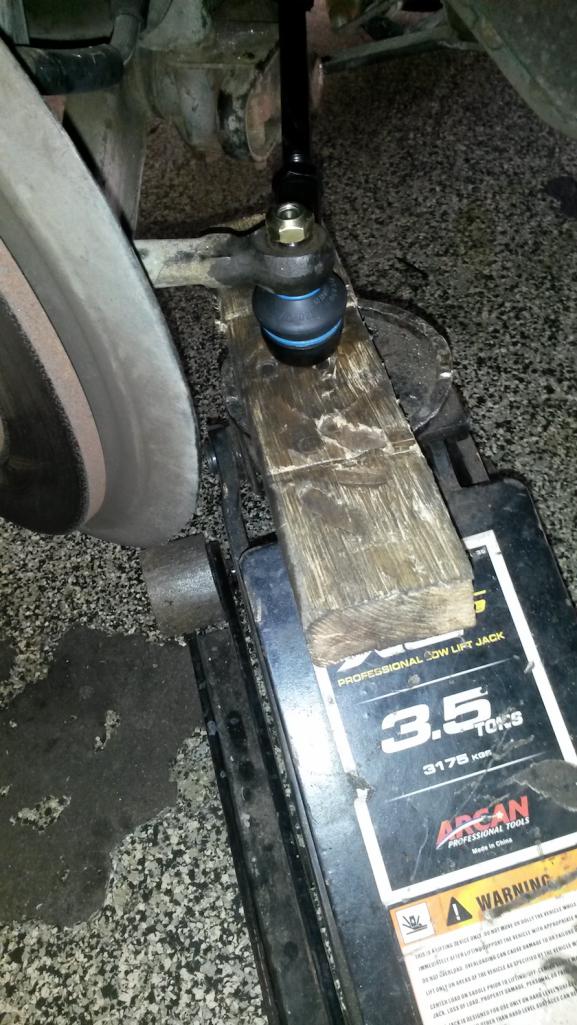 Torque the nut to 33 ft-lbs. Replace the wheel, and torque the wheel bolts to 108 ft-lbs. Funny, I'm having to split this write-up into 2 days just like the install. (IMG:style_emoticons/default/biggrin.gif) Attached thumbnail(s) 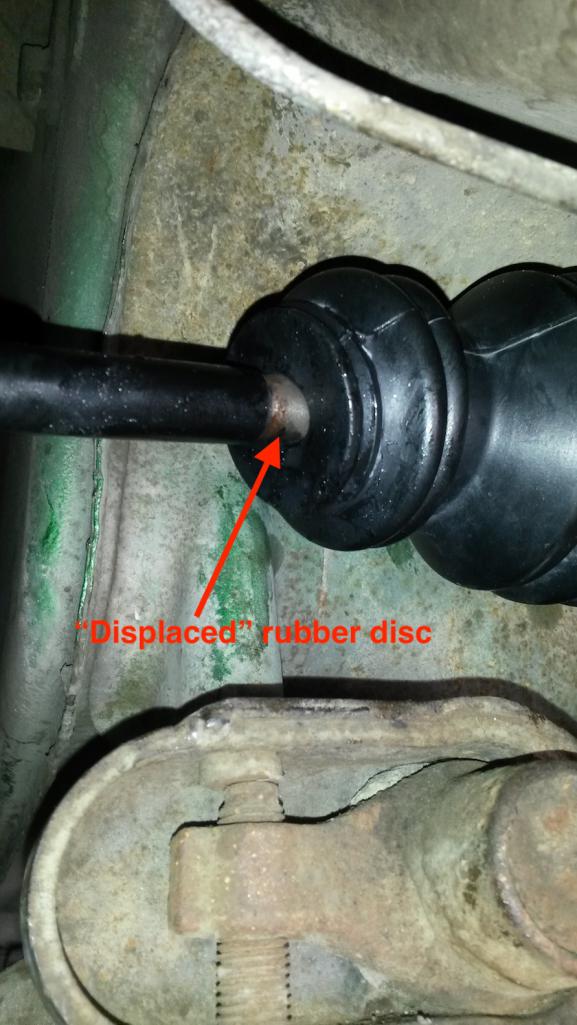
|
| iankarr |
 Jan 13 2020, 12:15 AM Jan 13 2020, 12:15 AM
Post
#6
|
|
The wrencher formerly known as Cuddy_K     Group: Members Posts: 2,561 Joined: 22-May 15 From: Heber City, UT Member No.: 18,749 Region Association: Intermountain Region 
|
Nicely done! Great details.
|
| soccerplyr |
 Jan 13 2020, 07:56 PM Jan 13 2020, 07:56 PM
Post
#7
|
|
Newbie  Group: Members Posts: 25 Joined: 31-August 13 From: Sandy, Utah Member No.: 16,329 Region Association: Rocky Mountains |
Thanks for posting. I bought some recently and plan on attempting as soon as it gets above freezing for a few days. Where did you get the tie rod wrench?
|
| anderssj |
 Jan 14 2020, 08:51 AM Jan 14 2020, 08:51 AM
Post
#8
|
|
Dog is my copilot...    Group: Members Posts: 1,748 Joined: 28-January 03 From: VA Member No.: 207 Region Association: MidAtlantic Region 
|
|
| anderssj |
 Jan 14 2020, 09:42 AM Jan 14 2020, 09:42 AM
Post
#9
|
|
Dog is my copilot...    Group: Members Posts: 1,748 Joined: 28-January 03 From: VA Member No.: 207 Region Association: MidAtlantic Region 
|
OK, on the driver's side things went much better. The outer tie rod end was secured with the proper castle nut and cotter pin, and the yoke/eye bolt came out easily once the boot retainer was loosened (the group buy wrench still worked well for that). Most important, I remembered to bring in a small (10-inch) pipe wrench to tighten the new turbo tie rod to the rack. No slipping, and fit well in the available work space.
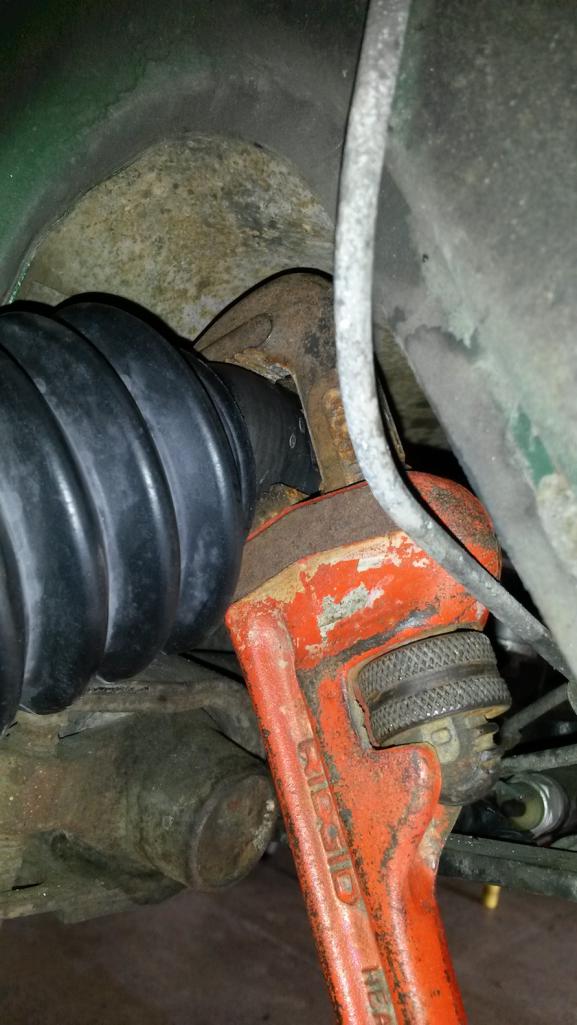 Once the old driver side tie rod was off, installing the new one was the same drill as on the passenger side: Clean the hole in the end of the rack with brake cleaner, Put the boot on the new tie rod and adjust it to the length of the old tie rod, Put a little thread locker on the stud and screw it in, Use the pipe wrench to tighten it to ~ 43 ft-lbs. Put some glycerin on the outer surface of the rack housing and the inner lip of the boot, and push/twist the boot into place Pull/"walk" the boot retaining spring back into place, twisting the boot as necessary for access. 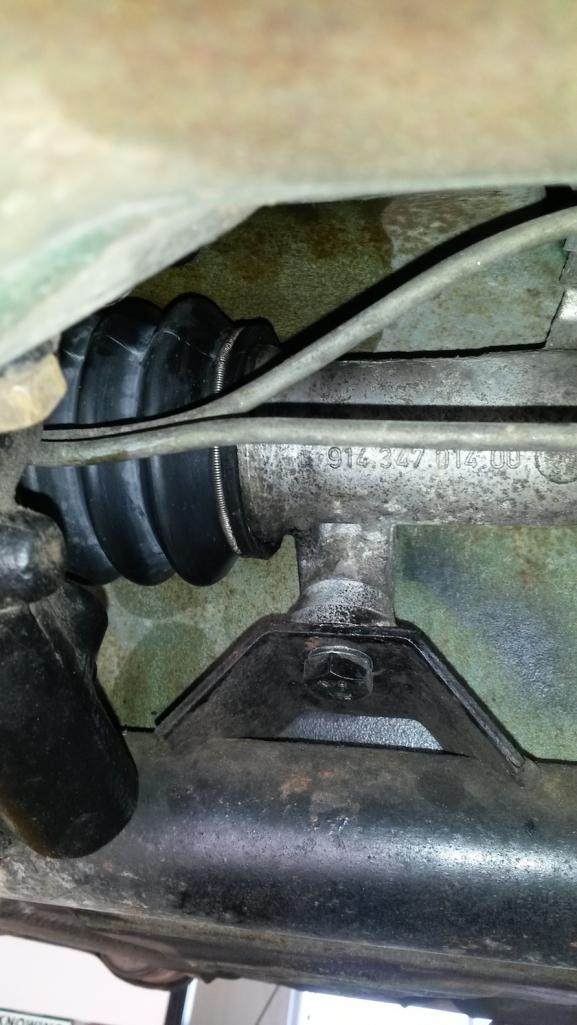 Put some glycerin on the rubber collar/disc on the tie rod and the outer lip of the boot, and push/twist the boot into place. Make sure the collar/disc isn't displaced; if it is, gently pull it back into place if you need to. 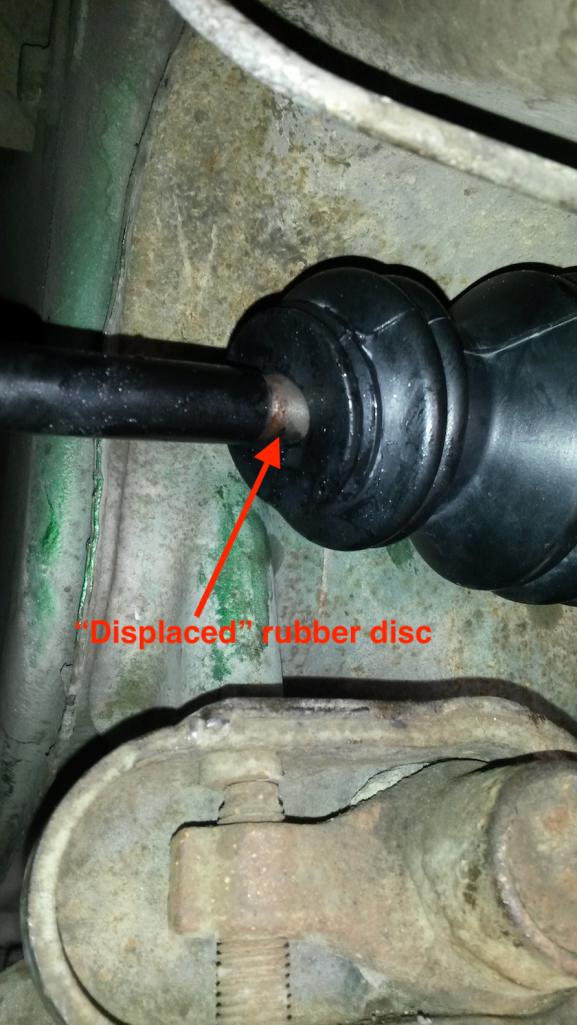 FWIW, this particular kit came without any small boot retainer springs for securing the outer end of the boots to the collars/discs. I used "zip ties" (as shown in this earlier pic) until I find something better. 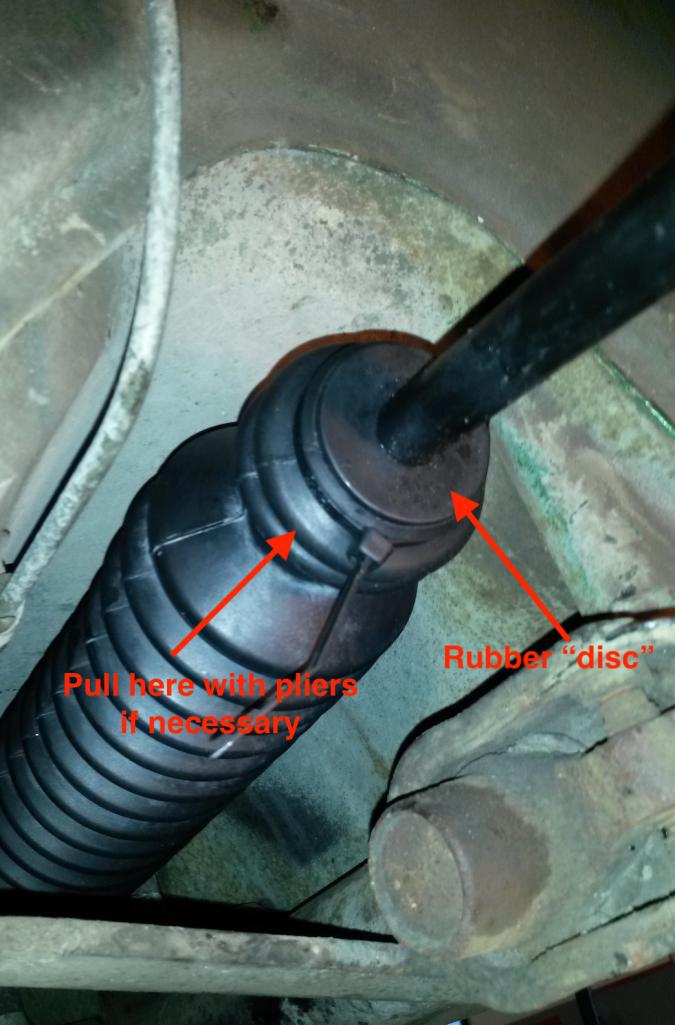 Lower the car, tighten the nut on the outer tie rod ball joint to 33 ft-lbs (again, use a jack and block to put upward pressure on the joint to keep the stud from turning) 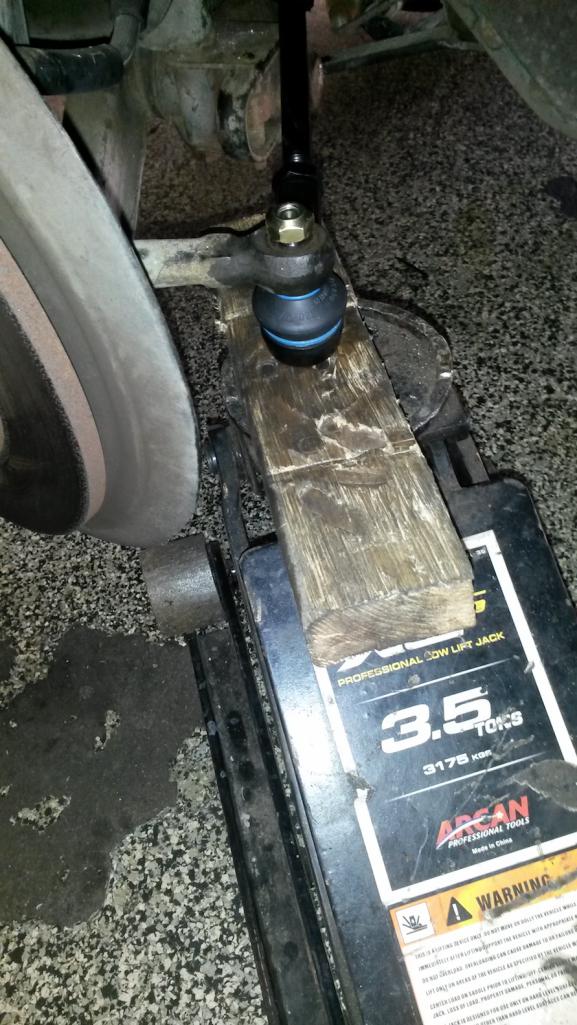 Reinstall the wheel and tighten lug bolts to 108 ft-lbs. Here's what it looks like when finished: 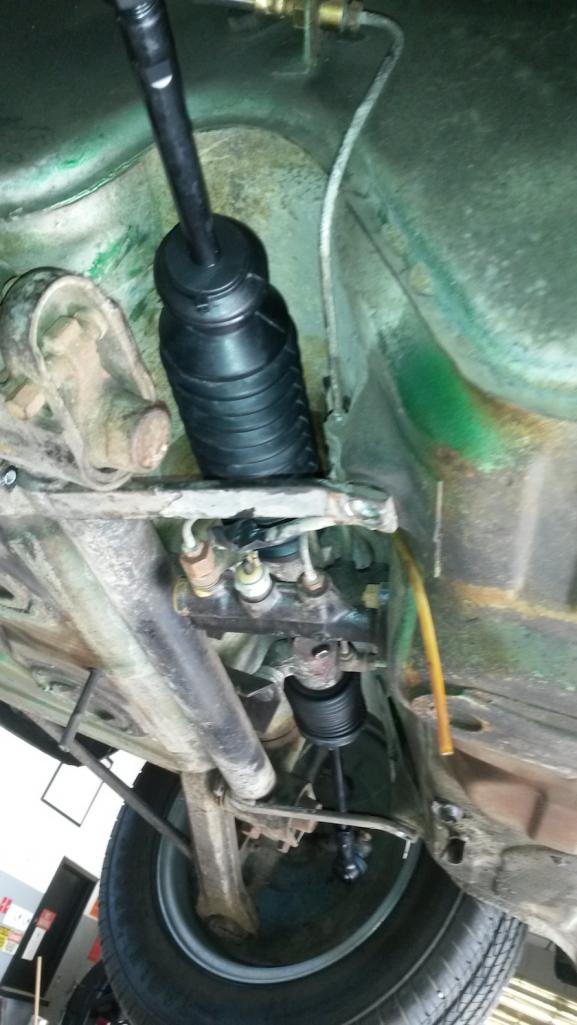 FWIW, it's always a good idea to go back through all the steps and mentally check my work...don't want any loose nuts/bolts. Also, while the splash pan is off the car, take a flashlight and check the brake master cylinder for dampness/leaks. You may want to take a look into the access hole under the fuel tank too--you might see your next repair: replacing the swollen fuel lines/hoses under the gas tank (IMG:style_emoticons/default/dry.gif) I think that's about it. Feel free to ask questions, or add your observations/BTDTs, etc. Hope this helps! |
| anderssj |
 Jan 14 2020, 11:26 AM Jan 14 2020, 11:26 AM
Post
#10
|
|
Dog is my copilot...    Group: Members Posts: 1,748 Joined: 28-January 03 From: VA Member No.: 207 Region Association: MidAtlantic Region 
|
Almost forgot...check your car's alignment after you're finished.
Specification is +20' + 10' total toe-in (with 15" wheels, 1/8-inch toe-in is about +18'). NOTE: there are 60 minutes (symbol ') in each degree, so total toe-in is only 1/3 of a degree... Check/set toe with a full fuel tank, as toe varies with weight on the front of the car (wheels will toe in a little more as the car gets lighter). |
  |
1 User(s) are reading this topic (1 Guests and 0 Anonymous Users)
0 Members:

|
Lo-Fi Version | Time is now: 3rd July 2025 - 07:25 AM |
Invision Power Board
v9.1.4 © 2025 IPS, Inc.








